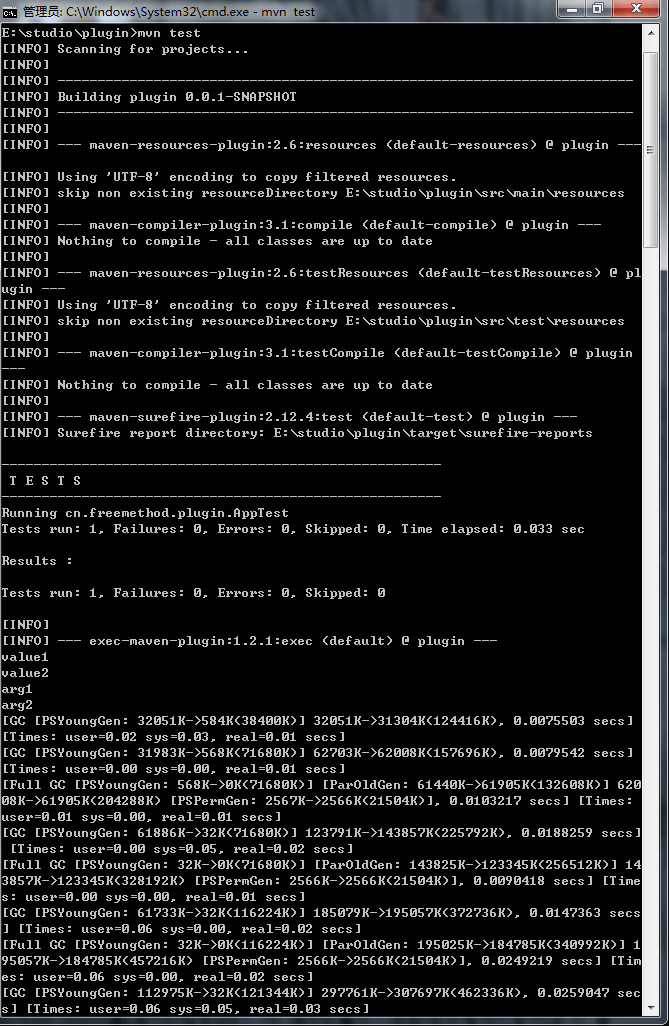您好,登錄后才能下訂單哦!
您好,登錄后才能下訂單哦!
這篇文章主要講解了“maven的exec-maven-plugin插件怎么使用”,文中的講解內容簡單清晰,易于學習與理解,下面請大家跟著小編的思路慢慢深入,一起來研究和學習“maven的exec-maven-plugin插件怎么使用”吧!
maven的exec-maven-plugin插件主要是用來執行可執行jar包命令的插件,很多工具提供命令行式的交互,例如mybatis-generator,每一次運行都會敲很長的命令,很麻煩。
還有的時候,你希望提供一個3方包給比人使用,為了讓別人能夠通過非常簡單的命令就可以運行程序,就可以使用exec-maven-plugin插件。
當然也可以是腳本的方式來實現,但是腳本的通用性不是很好,你要提供run.bat,run.sh等腳本。通過exec-maven-plugin就可以避免這樣的問題。
exec-maven-plugin插件有2個目錄(goal),一個是java一個是exec。這里簡單解釋一下maven的goal,可以把maven的goal看做是一個特定的功能,一個maven插件可能有很多功能,一個功能就是一個goal,maven還有生命周期的概念,maven有3套生命周期,分別是clean,default,site。每一個生命周期有包含一下階段(phase),可以把每一個階段看做一個流程。參加后面的maven生命周期。例如執行下面的2個命令:
mvn clean package mvn clean test
上面的2個命令都包含了2個生命周期,clean和default生命周期。clean會執行clean生命周期的pre-clean和clean階段,mvn clean package命令會從default生命周期會從validate執行到package階段,mvn clean test命令會從default生命周期的validate階段執行到package階段。
插件就是把goal綁定到生命指定階段的上執行的。就是maven在執行相應階段的時候會檢查有那些插件的goal綁定到這個階段上的,然后執行這些goal。
如果對這些知識有疑惑,強烈建議閱讀《maven實戰》。
public class App
{
public static void main( String[] args )
{
for(String arg : args){
System.out.println(arg);
}
}
}上面的代碼非常簡單,打印main方法參數。
<project xmlns="http://maven.apache.org/POM/4.0.0" xmlns:xsi="http://www.w3.org/2001/XMLSchema-instance"
xsi:schemaLocation="http://maven.apache.org/POM/4.0.0 http://maven.apache.org/xsd/maven-4.0.0.xsd">
<modelVersion>4.0.0</modelVersion>
<groupId>cn.freemethod</groupId>
<artifactId>plugin</artifactId>
<version>0.0.1-SNAPSHOT</version>
<packaging>jar</packaging>
<name>plugin</name>
<url>http://maven.apache.org</url>
<properties>
<project.build.sourceEncoding>UTF-8</project.build.sourceEncoding>
<exec_maven_plugin_version>1.2.1</exec_maven_plugin_version>
</properties>
<dependencies>
<dependency>
<groupId>junit</groupId>
<artifactId>junit</artifactId>
<version>4.9</version>
<scope>test</scope>
</dependency>
</dependencies>
<build>
<plugins>
<!-- http://www.mojohaus.org/exec-maven-plugin/ -->
<plugin>
<groupId>org.codehaus.mojo</groupId>
<artifactId>exec-maven-plugin</artifactId>
<version>${exec_maven_plugin_version}</version>
<executions>
<execution>
<phase>test</phase>
<goals>
<goal>java</goal>
</goals>
<configuration>
<mainClass>cn.freemethod.plugin.App</mainClass>
<arguments>
<argument>arg0</argument>
<argument>arg1</argument>
</arguments>
</configuration>
</execution>
</executions>
</plugin>
</plugins>
</build>
</project>看上面的配置,我們把exec-maven-plugin 插件的java模板(goal)綁定到了default生命周期的test階段上。所以我們只需要執行下面的命令就可以了:
mvn test
import java.util.ArrayList;
import java.util.List;
public class Exec {
public static void main(String[] args) {
System.out.println(System.getProperty("systemProperty1"));
System.out.println(System.getProperty("systemProperty2"));
for(String arg:args){
System.out.println(arg);
}
testGcTypeLog();
}
public static void testGcTypeLog(){
List<Object> list = new ArrayList<Object>();
while (true) {
byte[] m = costMemory(1024*1024*10);
list.add(m);
if(list.size()==90){
list.clear();
}
}
}
public static byte[] costMemory(int i) {
byte[] m = new byte[i];
return m;
}
}上面的例子就是打印指定的系統參數和不斷申請內存然后釋放內存,最要是為了觀察打印日志。
<project xmlns="http://maven.apache.org/POM/4.0.0" xmlns:xsi="http://www.w3.org/2001/XMLSchema-instance"
xsi:schemaLocation="http://maven.apache.org/POM/4.0.0 http://maven.apache.org/xsd/maven-4.0.0.xsd">
<modelVersion>4.0.0</modelVersion>
<groupId>cn.freemethod</groupId>
<artifactId>plugin</artifactId>
<version>0.0.1-SNAPSHOT</version>
<packaging>jar</packaging>
<name>plugin</name>
<url>http://maven.apache.org</url>
<properties>
<project.build.sourceEncoding>UTF-8</project.build.sourceEncoding>
<exec_maven_plugin_version>1.2.1</exec_maven_plugin_version>
</properties>
<dependencies>
<dependency>
<groupId>junit</groupId>
<artifactId>junit</artifactId>
<version>4.9</version>
<scope>test</scope>
</dependency>
</dependencies>
<build>
<plugins>
<!-- http://www.mojohaus.org/exec-maven-plugin/ -->
<plugin>
<groupId>org.codehaus.mojo</groupId>
<artifactId>exec-maven-plugin</artifactId>
<version>${exec_maven_plugin_version}</version>
<executions>
<execution>
<phase>test</phase>
<goals>
<goal>exec</goal>
</goals>
<configuration>
<executable>java</executable>
<arguments>
<argument>-DsystemProperty1=value1</argument>
<argument>-DsystemProperty2=value2</argument>
<argument>-XX:+PrintGCDetails</argument>
<argument>-classpath</argument>
<classpath />
<argument>cn.freemethod.plugin.Exec</argument>
<argument>arg1</argument>
<argument>arg2</argument>
</arguments>
</configuration>
</execution>
</executions>
</plugin>
</plugins>
</build>
</project>上面的配置我們也是把exec-maven-plugin插件的exec目標(goal)綁定到了default生命周期的test階段上,我們配置了-DsystemProperty1=value1設置系統參數,配置-XX:+PrintGCDetails設置jvm參數。
還是可以通過下面的命令來執行:
mvn test

從上圖可以看到打印了我們設置的系統參數,命令參數和gc日志。
當然也可以不綁定生命周期,可以像下面這樣配置:
<plugin>
<groupId>org.codehaus.mojo</groupId>
<artifactId>exec-maven-plugin</artifactId>
<version>${exec_maven_plugin_version}</version>
<configuration>
<executable>java</executable>
<arguments>
<argument>-DsystemProperty1=value1</argument>
<argument>-DsystemProperty2=value2</argument>
<argument>-XX:+PrintGCDetails</argument>
<argument>-classpath</argument>
<classpath />
<argument>cn.freemethod.plugin.Exec</argument>
<argument>arg1</argument>
<argument>arg2</argument>
</arguments>
</configuration>
</plugin>如果像上面這樣配置就需要先打包,然后執行exec:
mvn clean package mvn exec:exec
clean聲明周期:(3 phase(階段))
pre-clean
clean:清理上一次構建生成的文件
post-clean
default聲明周期:(23 phase)
validate
initialize
generate-sources
process-sources:處理項目主資源文件,拷貝src/main/resources 到classpath
generate-resources
process-resources
compile:編譯src/main/java代碼輸出到classpath
process-classes
generate-test-sources
process-test-sources:對src/test/resource目錄進行變量替換,拷貝到test的classpath
generate-test-resources
process-test-resources
test-compile
process-test-classes
test
prepare-package
package
pre-integration-test
integeration-test
post-integration-test
verify
install:安裝到本地倉庫
deploy
site生命周期:(4 phase)
pre-site
site
post-site
site-deploy
感謝各位的閱讀,以上就是“maven的exec-maven-plugin插件怎么使用”的內容了,經過本文的學習后,相信大家對maven的exec-maven-plugin插件怎么使用這一問題有了更深刻的體會,具體使用情況還需要大家實踐驗證。這里是億速云,小編將為大家推送更多相關知識點的文章,歡迎關注!
免責聲明:本站發布的內容(圖片、視頻和文字)以原創、轉載和分享為主,文章觀點不代表本網站立場,如果涉及侵權請聯系站長郵箱:is@yisu.com進行舉報,并提供相關證據,一經查實,將立刻刪除涉嫌侵權內容。